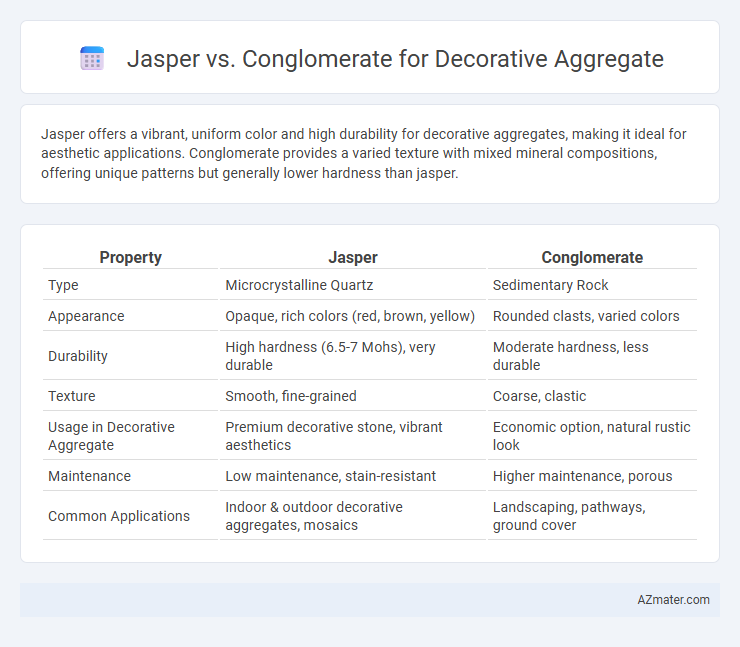Jasper offers a vibrant, uniform color and high durability for decorative aggregates, making it ideal for aesthetic applications. Conglomerate provides a varied texture with mixed mineral compositions, offering unique patterns but generally lower hardness than jasper.
Table of Comparison
| Property | Jasper | Conglomerate |
|---|---|---|
| Type | Microcrystalline Quartz | Sedimentary Rock |
| Appearance | Opaque, rich colors (red, brown, yellow) | Rounded clasts, varied colors |
| Durability | High hardness (6.5-7 Mohs), very durable | Moderate hardness, less durable |
| Texture | Smooth, fine-grained | Coarse, clastic |
| Usage in Decorative Aggregate | Premium decorative stone, vibrant aesthetics | Economic option, natural rustic look |
| Maintenance | Low maintenance, stain-resistant | Higher maintenance, porous |
| Common Applications | Indoor & outdoor decorative aggregates, mosaics | Landscaping, pathways, ground cover |
Introduction to Decorative Aggregates
Decorative aggregates such as Jasper and Conglomerate are popular choices in landscape design and architectural applications due to their unique textures and vibrant colors. Jasper, a form of chalcedony, is prized for its smooth surface and rich, earthy tones, making it ideal for intricate mosaic work and high-end decorative finishes. Conglomerate, composed of rounded clasts cemented together, offers a more natural, rustic appearance valued for pathways, garden beds, and exterior facades, providing both aesthetic appeal and durability.
Overview of Jasper as a Decorative Aggregate
Jasper, a durable and visually striking decorative aggregate, is prized for its rich, deep colors ranging from red to brown, offering a natural elegance to landscaping and architectural projects. Its high density and resistance to weathering make it suitable for both indoor and outdoor applications, maintaining aesthetic appeal over time. Compared to conglomerate, jasper provides a more consistent texture and color, enhancing design versatility in pathways, garden beds, and decorative concrete finishes.
Overview of Conglomerate as a Decorative Aggregate
Conglomerate as a decorative aggregate features rounded clasts embedded in a finer matrix, providing a distinctive, natural texture ideal for landscaping and architectural applications. Its varied grain sizes and colors create visually appealing surfaces that enhance aesthetic value and durability. Compared to jasper, conglomerate offers more diverse patterns and a rugged appearance, making it a versatile choice for decorative stone projects.
Key Physical Properties: Jasper vs Conglomerate
Jasper exhibits high hardness typically ranging from 6.5 to 7 on the Mohs scale, with a dense, fine-grained structure that enhances its durability and resistance to abrasions in decorative aggregates. Conglomerate, composed of rounded clasts cemented together, shows variable hardness depending on its matrix and clast composition, often softer overall compared to jasper. The uniform texture and low porosity of jasper contribute to its superior stability and aesthetic appeal in applications requiring durable decorative stone.
Color and Aesthetic Appeal Comparison
Jasper exhibits rich, earthy tones ranging from deep reds and browns to mossy greens, creating a natural, warm aesthetic ideal for decorative aggregate applications. Conglomerate offers a more varied color palette with multi-hued pebbles embedded in a matrix, delivering a distinctive, textured appearance that enhances visual interest. The choice between Jasper and Conglomerate depends on the desired color saturation and complexity in decorative aggregate design.
Durability and Longevity in Landscaping
Jasper exhibits exceptional durability in landscaping due to its dense crystalline structure, making it highly resistant to weathering and erosion. Conglomerate, composed of varied rock and mineral fragments cemented together, tends to have variable durability depending on its matrix and clast composition, often resulting in less longevity compared to jasper. For long-term decorative aggregate use, jasper is preferred for its sustained structural integrity and resistance to environmental wear.
Installation and Maintenance Requirements
Jasper decorative aggregate requires minimal installation effort due to its uniform size and smooth texture, allowing for easier spreading and compacting, which reduces labor time. Conglomerate decorative aggregate often demands more extensive site preparation and skilled installation to manage its varied size and rough texture, ensuring durability and proper drainage. Maintenance for Jasper is generally lower, as its consistent surface resists weed growth and settling, while Conglomerate may require frequent adjustment and debris removal to maintain appearance and structural integrity.
Cost Analysis: Jasper vs Conglomerate
Jasper typically incurs higher costs than conglomerate due to its denser composition and rarer availability, affecting extraction and processing expenses. Conglomerate, being more abundant and easier to quarry, often results in lower material and transportation costs for decorative aggregate projects. Cost analysis reveals that choosing conglomerate can optimize budget efficiency without significantly compromising aesthetic value.
Popular Applications and Design Ideas
Jasper and conglomerate both serve as popular decorative aggregates, each offering unique design possibilities. Jasper's rich color variations and fine-grained texture make it ideal for accent walls, countertops, and flooring that demand a polished, gemstone-like finish. Conglomerate's naturally embedded pebbles create a rugged, organic look perfect for outdoor landscaping, garden pathways, and rustic interior design elements.
Sustainability and Environmental Impact
Jasper decorative aggregate is valued for its natural origin, minimal processing requirements, and durability, resulting in a lower carbon footprint and reduced environmental impact compared to conglomerates. Conglomerate aggregates often undergo extensive quarrying and processing, increasing energy consumption and ecological disturbance. Sustainable sourcing of jasper aligns with eco-friendly construction practices, promoting long-term resource conservation and waste reduction.

Infographic: Jasper vs Conglomerate for Decorative Aggregate
 azmater.com
azmater.com